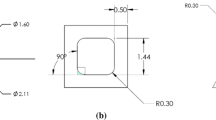Abstract
The amount of interfacial area formed during injection of gas into a liquid is important in mass transfer operations e.g. in gas washers and gas-liquid reactors. This paper describes an apparatus and a measuring technique for the investigation of bubble formation at sharp-edged and capillary orifices. Within the regime of single bubbles, the bubble formation was studied at atmospheric and higher pressures by taking high-speed films and simultaneously measuring the pressure fluctuations in the liquid and in the gas near the orifice. — Typical results for the bubble formation show a strong decrease of bubble volume with increasing system pressure, and a similar decrease of the pressure fluctuations in the liquid near the bubble. For sharp-edged orifices this decrease is markedly stronger than for capillaries.
Zusammenfassung
Die beim Dispergieren von Gasen in Flüssigkeiten gebildete PhasengrenzflÄche ist für zahlreiche technische StoffaustauschvorgÄnge von Bedeutung, z.B. in GaswÄschern, SÄttigern und Gas-Flüssig-Reaktoren. Es wird über eine Apparatur und eine Me\technik berichtet, mit der die Einzelblasenbildung an Lochblenden und Kapillaren bei AtmosphÄrendruck und höheren Systemdrücken durch Hochgeschwindigkeits-Filmaufnahmen und zeitlich korrelierte Messung der schnellen DruckÄnderungen in Flüssigkeit und Gas nahe der Begasungsöffnung untersucht wurde. — Anhand von typischen Messungen wird eine starke Abnahme des Blasenvolumens mit wachsendem Systemdruck und eine Ähnlich starke Abnahme der maximalen DruckÄnderungen in der Flüssigkeit nahe der Blase nachgewiesen. Diese Abnahme ist bei einer Lochblende erheblich grö\er als bei einer Kapillare.
Similar content being viewed by others
Literatur
Siemes, W.: Gasblasen in Flüssigkeiten. Teil I: Entstehung von Gasblasen an nach oben gerichteten kreisförmigen Düsen. Chem.-Ing.-Techn. 26 (1954) 479–496
Ramakrishnan, S.; Kumar, R.; Kuloor, N.R.: Studies in bubble formation. I: Bubble formation under constant flow conditions. Chem. Engng. Sci. 24 (1969) 731–747
Kumar, R.; Kuloor, N.R.: Bubble formation in viscous liquids under constant flow conditions. Can. Journ. Chem. Engng. 48 (1970)383–388
Buevich, Y.A.; Butkov, V.V.: The mechanism of bubble formation with the flow of gas out of a round opening into a liquid. Theor. Found. Chem. Engng. 5 (1971) 62–69
Ruff, K.: Bildung von Gasblasen an Düsen bei konstantem Volumendurchsatz. Chem.-Ing.- Techn. 44 (1972) 1360–1366
Ruff, K.: Grenze zwischen Blasengasen und Strahlgasen bei niedrigviskosen Flüssigkeiten und konstantem Gasvolumen-Durchsatz. Chem.-Ing.- Techn. 46 (1974) 769–771
Ruff, K.; Pilhofer, Th.; Mersmann, A.: VollstÄndige Durchströmung von Lochböden bei der Fluid-Dispergierung. Chem.-Ing.-Techn. 48 (1976) 759–764
Kling, G.: über die Dynamik der Blasenbildung beim Begasen von Flüssigkeiten unter Druck. Int. Journ. Heat Mass Transfer 5 (1962) 211–223
Durst, F.; Beer, H.: Blasenbildung an Düsen bei Gasdispersionen in Flüssigkeiten. Chem.-Ing.- Techn. 41 (1969) 1000–1006
McCann, D.J.; Prince, R.G.H.: Bubble formation and weeping at a submerged orifice. Chem. Engng. Sci. 24 (1969) 801–814
Kupferberg, A.: Jameson, G.J.: Bubble formation at a submerged orifice above a gas chamber of finite volume. Trans. Instn. Chem. Engrs. 47 (1969) 241–250
Kumar, R.; Kuloor, N.R.: The formation of bubbles and drops, in: Advances in Chemical Engineering 8 (1970) 255–368
La Nauze, R.D.; Harris, I.J.: The effect of pressure on the behaviour of gas bubbles formed at a single submerged orifice. Preprints der Gemeinsamen Tagung der VTG und der Instn. Chem. Engrs., S. 1–4. 1, Nürnberg 1971
Swope, R.D.: Single bubble formation at orifice submerged in viscous liquids. Can. Journ. Chem. Engng. 49 (1971) 169–174
Akita, K.; Yoshida, F.: Bubble size, interfacial area, and liquid-phase mass transfer coefficient in bubble columns. Ind. Engng. Chem., Process Des. Develop. 13 (1974) 84–91
Hayes, W.B.; Hardy, B.W.; Holland, C.D.: Formation of gas bubbles at submerged orifices. A.I.Ch.E. Journ. 5 (1959) 319–324
Khurana, A.K.; Kumar, R.: Studies in bubble formation-III. Chem. Engng. Sci. 24 (1969) 1711–1723
Satyanarayan, A.; Kumar, R.; Kuloor, N.R.: Studies in bubble formatio-II: Bubble formation under constant pressure conditions. Chem. Engng. Sci. 24 (1969) 749–761
Tavlarides, L.L.; Coulaloglou, C.A.; Zeitlin, M.A.; Klinzing, G.E.; Gal-or, B.: Bubble and drop phenomena. Ind. Engng. Chem. 62 (1970) 6–27
Jackson, R.: The formation and coalescence of drops and bubbles in liquids. The Chem. Eng. No. 178 (1964) CE 107-CE 118
Mersmann, A.: Auslegung und Ma\stabsvergrösserung von Blasen- und TropfensÄulen. Chem.- Ing.-Techn. 49 (1977) 679–691
Wraith, A.E.; Kakutani, T.: The pressure beneath a growing rising bubble. Chem. Engng. Sci. 29 (1974) 1–12
Sharma, M.M.; Danckwerts, P.V.: Chemical methods of measuring interfacial area and mass transfer coefficients in two-fluid systems. Brit. Chem. Engng. 15 (1970) 522–528
Author information
Authors and Affiliations
Rights and permissions
About this article
Cite this article
Kemnade, J., Bier, K., Gorenflo, D. et al. Blasenbildung und PhasengrenzflÄche beim Dispergieren von Gasen in Flüssigkeiten an einzelnen Gaszulauföffnungen. Wärme- und Stoffübertragung 11, 195–205 (1978). https://doi.org/10.1007/BF01805659
Received:
Issue Date:
DOI: https://doi.org/10.1007/BF01805659




